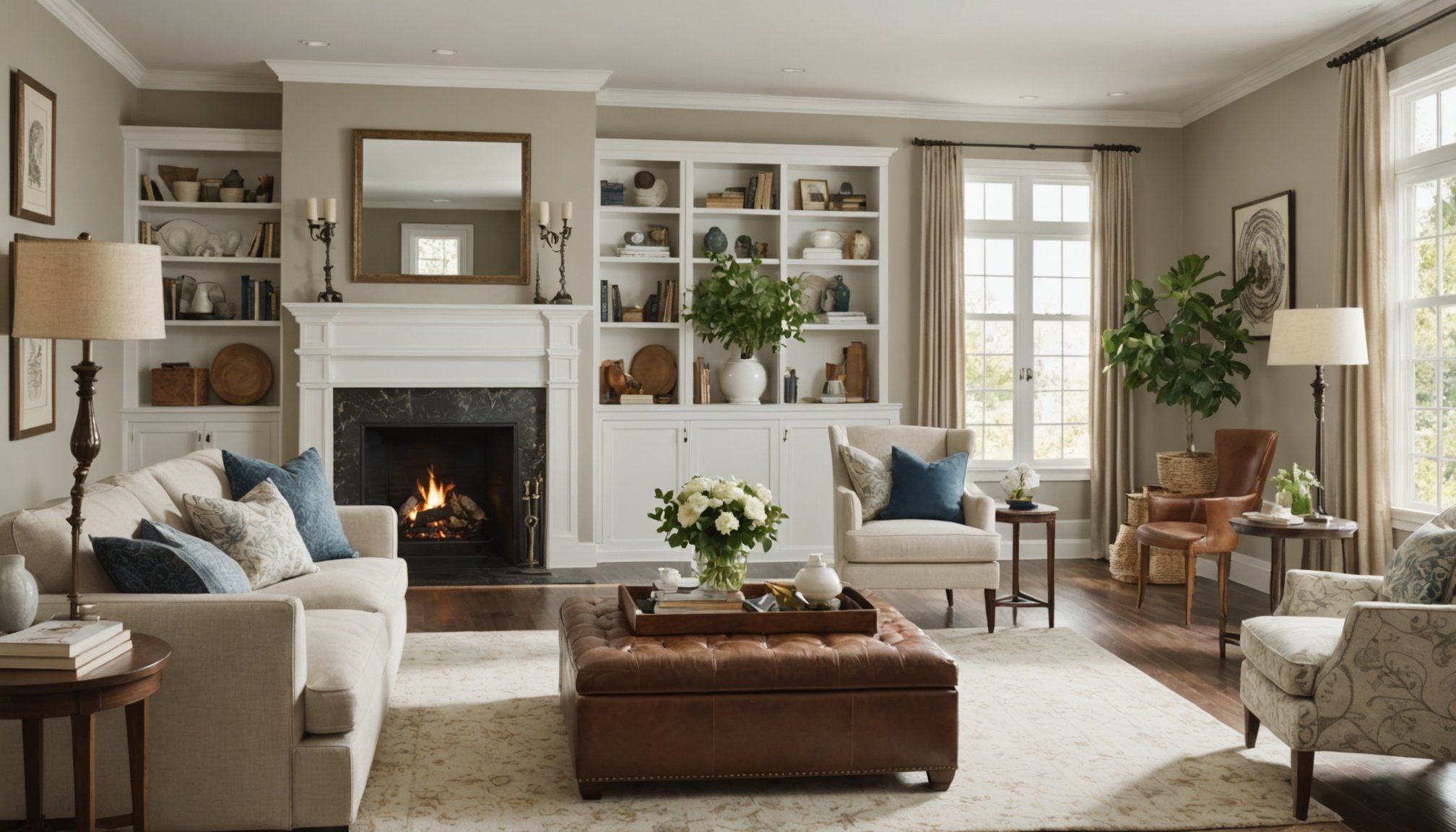The Importance of a Warm and Inviting Home
Creating a home environment that radiates warmth and invitation is crucial for personal growth and emotional well-being. The psychological impact of such a nurturing space cannot be understated. When our homes offer comfort and sanctuary, they foster personal success by providing a stable base from which to flourish.
Imagine returning each day to a welcoming environment. It not only rejuvenates but boosts emotional well-being, alleviating stress and anxiety. This emotional uplift is essential, as it enhances overall mood and productivity. The home serves as a personal haven, helping individuals face external challenges with greater resilience.
Also to see : Transformative Interior Design Trends in the UK for 2024: Expert Tips & Insights
Moreover, an inviting home fosters personal success by bolstering self-esteem and confidence. A place where one feels secure encourages risk-taking and growth beyond domestic walls. Positive home environments can often reflect and amplify personal achievements.
Integrating elements that resonate personally—such as favourite colours, meaningful artwork, or cherished furniture—can extensively highlight the importance of creating an embracing home space. Whether it’s through harmonious colours or a heartfelt photograph, elements that speak to one’s personal story elevate the emotional resonance of a home, making it a true reflection of self.
Also to see : Eco-Friendly Home Renovation Tips for Lasting Value and Sustainability
Furniture Arrangement for Comfort and Flow
Creating a comfortable and efficient home layout begins with understanding the principles of furniture arrangement. It’s essential to focus on promoting both comfort and flow within living spaces. A thoughtfully arranged room not only looks appealing but also enhances functionality and movement.
Begin by considering the flow of movement through each area. Ensure that there is ample space to walk around freely without obstacles. Position seating to foster communication, perhaps in a circle or semi-circle, inviting conversation and connection. The alignment of furniture pieces should not obstruct paths but instead guide them naturally.
Emphasize comfort by creating cozy seating areas. Arrange sofas and chairs to face each other, perhaps around a central coffee table. Incorporate soft textiles like cushions and throws to add warmth and make lounging inviting. Don’t shy away from rearranging large items until you achieve the right balance in space utilization.
Think about how different areas of a room can serve multiple functions. For instance, an ottoman can double as seating or a coffee table. The key is versatility but also ensuring that each furniture piece contributes to the ease and comfort of the space, without over cluttering. A well-arranged room can transform the home environment into a haven.
Color Psychology in Home Decor
Exploring the psychological impact of colors in a home environment reveals its powerful influence on mood and productivity. Colors significantly affect how we perceive spaces, guiding emotional responses and behavior. Choosing the right colors can transform a house into a tranquil haven or a dynamic powerhouse.
Understanding Warm Colors
Warm colors, such as reds, oranges, and yellows, evoke feelings of energy and passion. These hues can stimulate conversation and creativity, making them ideal for social spaces like living rooms or kitchens. Embracing warm tones helps create an inviting and lively atmosphere.
The Influence of Cool Colors
In contrast, cool colors like blues, greens, and purples promote calmness and relaxation. These tones are perfect for bedrooms or bathrooms, where a sense of peace is desirable. Implementing cool colors can enhance tranquillity and aid in stress relief, fostering personal success in a nurturing environment.
Balancing Colors for Harmony
Achieving a harmonious blend involves balancing warm and cool tones throughout the home. Neutral colors can serve as a unifying backdrop, allowing certain accents to stand out while maintaining flow. Strive for palettes that encompass both vibrancy and relaxation, ensuring each room embodies a unique yet cohesive story. This balance in color choices significantly impacts the overall success of home environments.
Incorporating Personal Touches and Sentiment
Incorporating personal touches into your home is pivotal for creating a space that resonates emotionally and amplifies warmth. These additions can transform a house into a unique sanctuary, reflective of your personal journey.
Personal items—be it photographs, art, or trophies—enhance the emotional warmth of a home. Displaying cherished memories effectively not only beautifies the space but also instils a sense of belonging and personal history. Strategically positioned photographs can narrate stories or commemorate milestones, offering inspirational focal points within rooms.
Balancing these personal elements with functionality is crucial. Aim to integrate personal style while maintaining the functionality of the space. Consider multifunctional furniture pieces that include display sections to showcase personal items without compromising utility. A well-placed shelf or a designated corner can serve as a mini-gallery of personal treasures.
To prevent clutter and ensure a harmonious home, choose personal accents that align with the room’s theme and avoid overwhelming the space. This thoughtful approach enables you to cherish personal stories while fostering a warm, inviting environment that supports both relaxation and personal expression. With the right balance, personal touches can significantly enhance both the aesthetics and emotional comfort of your home.
Organization Techniques for a Harmonious Home
Creating a well-organized home through effective decluttering and storage solutions can significantly enhance both productivity and stress reduction. Let’s explore some key strategies to establish and maintain organized spaces.
The Benefits of Decluttering
Decluttering can reveal optimal space utilization, paving the way for a calm, efficient environment. This process reduces visual noise and sources of stress, providing clearer paths and a more tranquil atmosphere. Consider removing items that no longer serve a purpose, thus allowing for intentional organization.
Smart Storage Ideas
Investing in versatile storage solutions is crucial. Options like multi-functional furniture or built-in shelving increase storage capacity without sacrificing space. Use baskets or under-bed boxes to store seldom-used items. Vertical storage, such as stackable bins, maximizes limited space, making everything accessible and neat.
Maintaining Organized Spaces
Consistency is key in maintaining organisation. Regularly review and reassess your belongings, ensuring everything has a designated place. Labels can ease locating items, and setting aside time weekly for tidying can prevent clutter buildup. These habits support a harmonious home, enhancing both your productivity and peace of mind.
Creating an Emotional Atmosphere
Achieving the optimum atmosphere and ambiance in your home involves a careful blend of lighting, natural elements, and sensory experiences. Lighting is a powerful tool that directly impacts mood—soft, warm lights create a cozy atmosphere conducive to relaxation, while brighter lights promote alertness and energy for activities. Consider using dimmers to easily adjust lighting according to desired tasks or moods.
In addition to lighting, integrating nature into your home design through plants and natural elements can significantly uplift the ambiance. Houseplants not only improve air quality but also offer a calming presence. A strategically placed fern or a cascading pothos can transform a sterile space into a living, breathing oasis.
Moreover, scents and textures play a unique role in creating a warm environment. Natural textures, like wooden furniture or woven textiles, enhance tactile experiences and add warmth to any room. Introducing pleasant scents, whether through candles, essential oils, or fresh flowers, can elevate the emotional tone of a space, making it inviting and comforting.
By focusing on these elements, you can create an emotional atmosphere that supports well-being and mirrors your personal preferences. Each component serves to harmonize the environment, offering both comfort and serenity in your home.
Inspirational Home Decor Ideas
Designing a space that truly feels like home doesn’t have to break the bank. By focusing on budget-friendly decor tips, you can elevate your home’s aesthetics without overspending. Start by repurposing items you already own. A fresh coat of paint on furniture or a creatively upcycled piece can breathe new life into any area. Swap pillow covers seasonally to change the mood or add inexpensive wall decals for a personal touch.
DIY Projects to Personalize Your Space
Unleash your creativity with DIY projects. Crafting custom decor not only saves money but also infuses your home with unique character. Consider simple projects such as making a photo gallery wall or creating homemade candles with your favourite scents. Try building a small bookshelf or designing your own wall art; these projects reflect personal interests and ensure your space is one-of-a-kind.
Incorporating Art and Culture
Art and culture add depth and intrigue to your home environment. Incorporate pieces that celebrate cultural elements or personal heritage. This could involve showcasing art from local galleries or integrating cultural textiles. Art doesn’t just beautify a room; it contributes to an inviting and dynamic atmosphere that reflects a rich tapestry of stories and influences.







